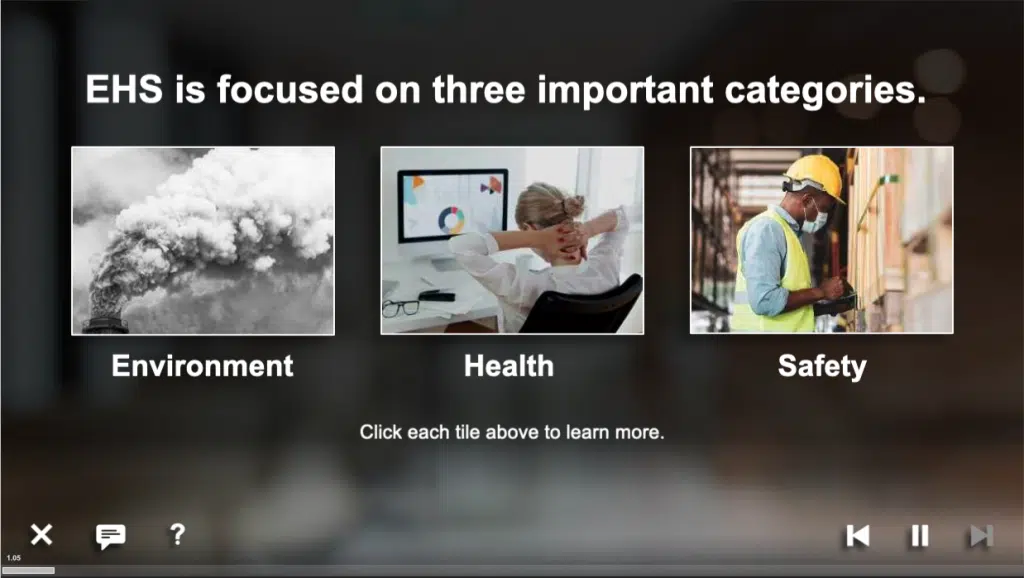
Environment Health & Safety
Your employees’ health and well-being are a priority. Protect your organization and your teams by helping create a secure environment both inside and outside the workplace.
Course description
This 30-minute interactive course introduces employees and managers to crucial EHS topics and their role in ensuring a safe, secure and healthy work culture. A video host guides learners through 3 brief episodes that feature real-world examples and everyday actions that help employees stay healthy and safe and reduce EHS risks. Viewer email, tweets and other interactions reinforce key concepts, address common questions and boost knowledge retention.
ONLINE TRAINING
Environment Health and Safety

The course covers these relevant topics and more:
- What is Environment, Health & Safety (EHS)?
- Key EHS laws
- Different types of workplace hazards
- PPE (personal protective equipment)
- MSDs (work-related musculoskeletal disorders)
- Office ergonomics
- Worker health and wellbeing
- Physical security
- Information security
- Workplace violence
- Emergencies and emergency action plans
- Fire safety
- Environmental concerns
- Reporting hazards or concerns
KEY FEATURES
Why you'll love our training
It’s time to embrace a new era of online training with a valued partner who will ensure seamless implementation, along with a learning experience your employees will truly enjoy.
Course administration
Traliant makes it simple to roll out training to your workplace and provide technical support directly to your employees at no additional cost.
Course customizations
Tailor courses to include your logo, relevant policies, workplace images, and more. Traliant can even customize the course with scenarios that take place in your own workplace environment.
Translations
Training is available in English, Spanish and is supported in over 100 languages.
What to consider when choosing the most effective environment, health, and safety (EHS) training

- Promote a culture of safety: EHS training fosters a culture where safety is a top priority, and where employees are encouraged to identify and report hazards.
- Comply with regulations: Organizations are subject to a variety of EHS regulations. Training helps to ensure that organizations are complying with these regulations and to avoid fines and penalties.
- Reduce the risk of accidents and injuries: A well-trained workforce is less likely to experience accidents and injuries, which can save organizations time, money, and resources.
- Empower employees: Training provides employees with the knowledge and skills they need to identify and address workplace hazards, report safety concerns, and understand their rights under EHS regulations.
- Strengthen your organization's commitment to safety: Training demonstrates the company's commitment to providing a safe and healthy working environment and to complying with EHS regulations.
- Reduce the risk of OSHA violations and penalties: Training helps to ensure that organizations are complying with OSHA standards and to minimize the risk of fines and penalties.
- Workplace hazards: Training helps employees to identify and understand common workplace hazards, such as:
- Physical hazards: Slips, trips, and falls; working at heights; machinery; electricity; noise; heat; and cold.
- Chemical hazards: Exposure to hazardous substances, such as chemicals, solvents, and dust.
- Biological hazards: Exposure to bacteria, viruses, and other microorganisms.
- Ergonomic hazards: Risks associated with awkward postures, repetitive motions, and forceful exertions.
- Environmental safety topics: Training addresses environmental concerns, including pollution prevention, waste management, and conservation of resources.
- Risk assessment: Training should cover how to conduct risk assessments to identify and evaluate potential hazards.
- Personal protective equipment (PPE): Training should address the proper use, selection, and maintenance of PPE.
- Emergency procedures: Training should cover emergency procedures, including evacuation plans, first aid, and reporting procedures.
- Fire safety: Training should address fire prevention, fire safety equipment, and evacuation procedures.
- Slips, trips, and falls: These are among the most common workplace accidents. They can be prevented by keeping floors clean and dry, providing adequate lighting, and using non-slip mats.
- Exposure to hazardous substances: Chemicals, dusts, fumes, and other substances can pose health risks. Control measures can include using ventilation systems, providing personal protective equipment (PPE), and training employees on safe handling procedures.
- Ergonomic hazards: Awkward postures, repetitive motions, and forceful exertions can lead to musculoskeletal disorders (MSDs). Ergonomic assessments and adjustments to workstations can help to prevent MSDs.
- Workplace violence: Employees may be at risk of violence from customers, clients, or co-workers. Training can help to de-escalate potentially violent situations and to establish procedures for reporting incidents.






